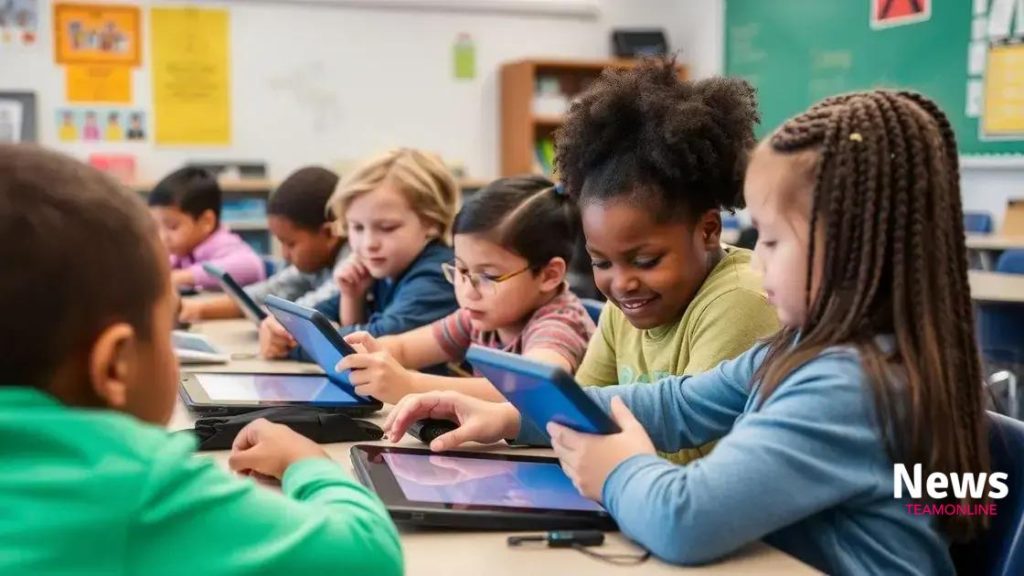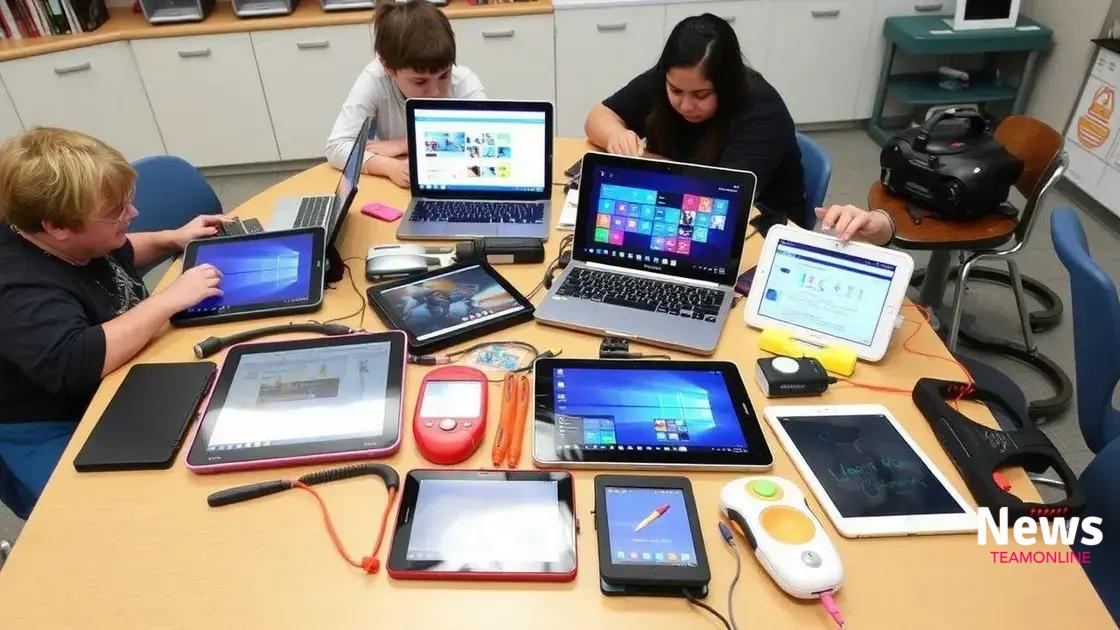EdTech usage in special education: enhancing learning experiences

EdTech usage in special education enhances learning by leveraging tools like AI, VR, and collaborative platforms, allowing personalized, engaging, and effective educational experiences for students with diverse needs.
EdTech usage in special education is transforming the way we approach learning for students with unique needs. With the right tools, we can create more inclusive classrooms that empower every learner. Have you ever thought about how technology could make a difference?
Understanding EdTech in special education
Understanding EdTech in special education helps us see how technology can enhance learning experiences for students with diverse needs. By integrating digital tools, we can create personalized pathways that engage learners effectively.
What is EdTech?
EdTech, or educational technology, includes a variety of tools and resources designed to support teaching and learning. In special education, these technologies are tailored to meet individual needs, creating opportunities for success.
Benefits of EdTech in Special Education
There are numerous advantages to using EdTech in special education classrooms:
- Enhances individual learning experiences
- Promotes engagement through interactive tools
- Facilitates communication between students and teachers
- Supports diverse learning styles and needs
Moreover, EdTech fosters a sense of independence among students. When learners interact with technology, they can progress at their own pace, building confidence along the way. This autonomy can be vital for their growth and development.
Additionally, teachers benefit from using these tools. They can track student performance, adapt lessons, and provide immediate feedback. This dynamic environment not only supports learners but also empowers educators to be more effective in their roles.
Examples of EdTech Tools
Some popular EdTech tools used in special education include:
- Speech-to-text software for students with writing difficulties
- Interactive apps that gamify learning
- Augmented reality tools that visualize concepts
By leveraging technology, teachers can create an inclusive atmosphere where every student feels valued. With the right tools, the classroom becomes a rich learning environment that celebrates differences.
Key benefits of educational technology
The key benefits of educational technology are transforming the landscape of learning, especially in special education. These tools make learning more accessible and engaging for all students. They can tailor instruction to meet individual needs, offering each student a better chance at success.
Personalized Learning
One of the most significant advantages is the ability to provide personalized learning experiences. With technology, teachers can customize lessons based on students’ unique requirements. This customization allows for:
- Adaptive learning paths that match student pace.
- Immediate feedback to guide understanding.
- Access to resources that suit individual learning styles.
This personalized approach ensures that no student is left behind, fostering a supportive educational environment.
Enhanced Engagement
Another key benefit is increased student engagement. When students interact with technology, they often feel more motivated and excited about their learning. Tools like educational games and interactive software can make lessons more enjoyable. This enhanced engagement can lead to:
- A greater willingness to participate in class activities.
- Improved retention of information.
- Higher levels of creativity in problem-solving tasks.
This engagement is crucial for students with special needs, as it can help them connect better with the material being taught.
Furthermore, educational technology fosters collaboration among students. Online platforms allow students to work together on projects, share ideas, and learn from each other. This collaboration enhances communication skills and builds a sense of community within the classroom.
Ultimately, the key benefits of educational technology extend beyond just improving grades. They also contribute to developing critical life skills, preparing students for future challenges. As technology continues to evolve, its role in enhancing education will only grow.
Tools and platforms enhancing learning

Tools and platforms enhancing learning are essential in modern education, especially in special education settings. These resources empower both teachers and students to achieve their learning goals effectively. Many tools offer unique features tailored to meet specific needs.
Types of Learning Tools
Various tools and platforms are available to support learning enhancement:
- Interactive Software: Programs that offer engaging activities and lessons.
- Learning Management Systems (LMS): Platforms that organize educational resources and track student progress.
- Communication Tools: Apps that facilitate interaction between students and teachers.
- Assistive Technology: Devices designed to help students with disabilities.
These tools transform the traditional learning experience into an interactive and enjoyable process. Students can learn at their own pace, making the educational journey more personalized.
Benefits of Using Platforms
Employing these platforms brings multiple benefits. They allow for:
- Access to a vast array of resources.
- Flexibility in learning schedules.
- Immediate feedback to improve performance.
Utilizing technology helps educators create a more inclusive atmosphere. For example, online platforms can adapt lessons for different learning styles. Students who might struggle in a standard classroom can thrive in a tech-enhanced environment.
Moreover, these platforms foster a collaborative spirit among students. They can communicate and work together on projects, which builds teamwork and social skills. When students engage with each other through technology, they often become more comfortable sharing ideas and exploring complex concepts.
With the rise of educational technology, teachers and students alike can take advantage of innovative tools that support learning. Adopting these platforms is not just about keeping up with trends; it’s about providing every student with the best possible education.
Real-life success stories
Real-life success stories highlight the impact of educational technology in special education settings. These stories inspire and provide hope, showcasing how technology can significantly help students with diverse needs. Each story demonstrates a unique approach to using technology for learning.
Individual Case Studies
One remarkable example is a student named Alex, who struggled with communication due to a speech impairment. By using a speech-generating device, he could express his thoughts more freely. This technology opened doors for social interaction and boosted his confidence in participating in class discussions.
Group Projects
In another case, a group of students with various learning challenges collaborated on a science project using an interactive platform. They used digital tools to conduct experiments and record findings. The experience not only improved their understanding of scientific concepts but also enhanced their teamwork skills. This collaboration led to:
- Higher levels of engagement.
- Improved problem-solving abilities.
- Strengthened communication among peers.
Furthermore, a school implemented a new reading app designed for special education students. As a result, many students showed significant improvement in reading comprehension and fluency over a single semester. Teachers reported increased motivation as students engaged with the content more fully.
These success stories remind us that technology is not just a tool but a bridge to greater opportunities. They serve as testimonials to the transformative power of EdTech, giving educators new ways to connect with their students and help them succeed.
Future trends in EdTech for special needs
Future trends in EdTech for special needs show great promise for enhancing the educational experience. As technology continues to evolve, the potential for innovative solutions grows. These trends aim to make learning more accessible, engaging, and tailored to the unique needs of every student.
Artificial Intelligence in Education
One major trend is the integration of artificial intelligence (AI) into educational tools. AI can analyze student performance and offer personalized learning paths. By assessing how each student learns best, AI can suggest tailored resources and activities that suit their learning style, ultimately resulting in better educational outcomes.
Virtual and Augmented Reality
Another exciting development is the use of virtual reality (VR) and augmented reality (AR)
In addition, AR can enhance traditional textbooks and classroom materials, providing interactive elements that make learning more engaging. When students can visualize concepts, they often find it easier to comprehend challenging subjects. Furthermore, the trend of mobile learning is growing. With the widespread use of smartphones and tablets, educational apps empower students to learn anytime and anywhere. This accessibility allows students with special needs to practice skills at their own pace, making education more flexible and adaptive. Future trends also include the rise of collaborative learning platforms. These platforms connect students, teachers, and parents, fostering a community of support. Through discussion forums, messaging features, and shared projects, students can collaborate with each other, helping them develop social skills and teamwork. As more educators adopt these platforms, the classroom will transform into a dynamic learning space that emphasizes interaction and engagement. These collaborative tools will provide essential feedback and encourage students to connect deeply with their peers. In conclusion, the advancements in educational technology have the potential to transform special education. With tools like AI, VR, and collaborative platforms, students with special needs can enjoy personalized learning experiences that cater to their individual strengths. By embracing these innovations, educators can create inclusive environments where all students thrive. Continuous exploration of future trends will ensure that learning remains engaging and effective for everyone. AI provides personalized learning experiences by adjusting content and pace based on each student’s unique needs and performance. Virtual reality immerses students in engaging environments, allowing them to practice skills and explore concepts in a safe setting. Mobile learning offers flexibility, enabling students to access educational resources and practice skills at their own pace, anywhere. Collaborative learning platforms connect students and teachers, enhancing communication and teamwork, making learning more interactive and supportive.Collaborative Learning Platforms
FAQ – Frequently Asked Questions about EdTech in Special Education
How does artificial intelligence enhance learning for students with special needs?
What role does virtual reality play in special education?
How can mobile learning benefit students with disabilities?
What are collaborative learning platforms and why are they important?





